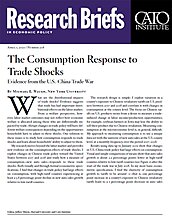My research moves beyond the labor market and provides new evidence on the consumption effects of trade shocks. I exploit changes in Chinese trade policy toward the United States between 2017 and 2018 and study how a measure of consumption—new auto sales—responds to these trade shocks. Both visually and through formal econometric specifications, I find that changes in trade policy had large effects on consumption, with high-tariff counties experiencing at least a 3.8 percentage point decline in new auto sales growth relative to low-tariff counties.
The research design is simple: I exploit variation in a county’s exposure to Chinese retaliatory tariffs on U.S. products between 2017 and 2018 and correlate it with changes in consumption at the county level. The focus on Chinese tariffs on U.S. products stems from a desire to measure a trade-induced change in labor income/production opportunities; for example, soybean farmers in Iowa may lose the ability to sell their product due to Chinese retaliation. Measuring consumption at the microeconomic level is, in general, difficult. My approach to measuring consumption is to use a unique data set with the universe of new auto sales at the U.S. county level, at a monthly frequency, over the period 2017–2018.
Results using data up to January 2019 show that changes in U.S.-China trade policy had large effects on consumption. Visual and simple comparisons of means show that auto sales growth is about 2.5 percentage points lower in high-tariff counties relative to low-tariff counties (see Figure 1) after the start of the trade war in July 2018. In my most basic econometric specification, I find the elasticity of consumption growth to tariffs to be around −1—that is, one percentage point increase in a county’s exposure to Chinese retaliatory tariffs leads to a 1 percentage point decrease in auto sales growth. In terms of magnitudes, this elasticity implies a nearly 3.8 percentage point decline in auto sales growth for counties in the upper quartile of the tariff distribution relative to counties in the lower quartile. Under certain assumptions, these estimates imply a decrease in aggregate consumption of up to $54 billion. While modest in aggregate, this effect is concentrated with high-tariff counties experiencing a decrease in aggregate consumption of up to $1,600 per worker.

